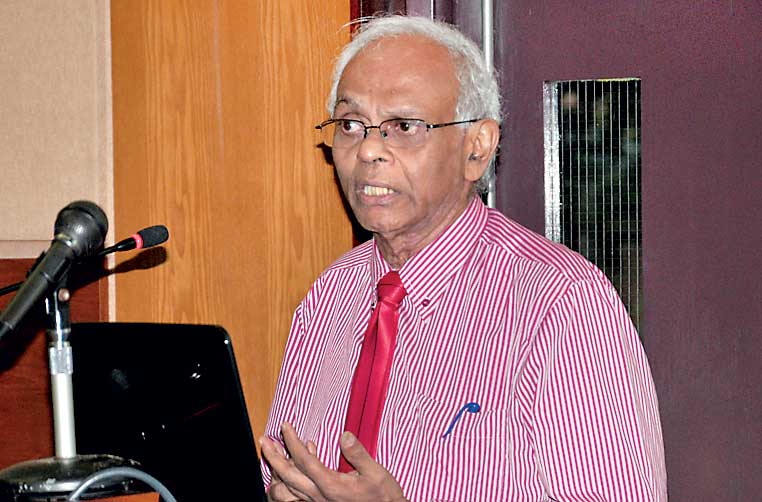Thursday Nov 27, 2025
Thursday Nov 27, 2025
Friday, 22 May 2015 00:18 - - {{hitsCtrl.values.hits}}

Former Deputy Governor of the Central Bank of Sri Lanka
W. A. Wijewardena – Pic by Sameera Wijesinghe
By Charumini de Silva
Sri Lanka needs to pay urgent attention to implementing a new banking policy which will encourage banks to channel their profits towards technological development, which will eventually benefit customers, a senior banker said.
Former Central Bank Deputy Governor W.A. Wijewardena pointed out that most banks in Sri Lanka needed to improve their use of technology in order to carry out their operations effectively.
“The banks are in a wave of technology which started in the 1990s. Now we are in 2015 and we have to cater to a new kind of customer called a Generation Y customer. Nevertheless, our banks are not yet ready to serve Generation Y customers because we do not have the right technology available,” he stated.
Wijewardena aired these views at the launch of the Economic and Social Survey of Asia and the Pacific 2015 – Part I under the theme of ‘Making Growth More Inclusive for Sustainable Development’.
Therefore, he emphasised, that it was imperative that banks invested in technological advancements.
“We need an urgent banking policy which will encourage banks to reflow their profits back into technological development, which will enable them to increase interest rates of savings accounts while reducing lending rates and having a narrower margin that could actually benefit consumers,” he noted.Commenting on the current low interest rate regime, Wijewardena said that the banks were presently riding on the low-interest rate policy of the Central Bank, where banks had complemented the regulator’s wish on the deposit side.
Elaborating on his point, Wijewardena said that the rates of the deposit side had been cut down to the bare minimum.
“Although some of the banks claimed that they were paying an interest rate of 4% on savings accounts, in actuality the interest rate comes to about 2%. However, the average lending rates are around 9% to 10% and as a result you would have seen all the banks have made billions and billions as profits in 2013-14,” he said.
Wijewardena raised concerns over huge profit margins and asserted that this was a matter somebody would have to look at seriously.
“Should the banking industry make such a huge profit? And if those profits are made by the banks, how can it be used by the banking industry to develop itself further?” he asked.
Sri Lanka’s economy has been flooded with excess liquidity of Rs. 250 billion for the past one and half years due to structural issues in the economy, a senior banker said.
Former Central Bank Deputy Governor W.A. Wijewardena said that from January 2014 there was continuous excess liquidity of Rs. 200 to Rs. 250 billion in the economy. The excess liquidity in the economy was a result of reduced private sector borrowings from banks and the Central Bank, allowing banks to borrow abroad in foreign exchange to recapitalise themselves.
“Generally in a situation the Central Bank shifts from excess liquidity to deficit liquidity. One day you will be accepting the deposits from the banks and the other day you will be providing funds to the banks. This is the normal situation where we will be facing the Monetary Policy challenges.
“But what happened here was that all the funds came back into the system. Banks were borrowing aboard to recapitalise themselves, the Government was borrowing through sovereign loans and at the same time, the Government was spending money. So, the money is there just like a flood,” he said.
He recalled that a few years ago Bangkok got flooded with excess liquidity and it was under flood for about six months.
Noting that the economy was under an excess liquidity flood for over one and half years, he asserted that it was now a matter of the Central Bank designing a strategy to take it out permanently.
“We have actually become prisoners of past policies. Now it is a matter for us to take the prisoner out and see how we can free him.”
Acknowledging the risk behind curtailing the excess liquidity, Wijewardena stated: “When you take it out permanently, we have to cut down the interest rates further. But cutting down interest rates further is a risky matter at this particular point in time. We have been able to build up our foreign reserves amounting to about $ 3.5 billion by selling out Treasury bills at high interest rates to the US and if we cut it down to the local interest rates that money will go out overnight.”
At present, Sri Lanka’s foreign reserves amount to about $ 7.5 billion. “If $ 3.5 billion goes out from the economy, I don’t know where our exchange rate would stand,” he cautioned.
Wijewardena made these remarks at the launch of the Economic and Social Survey of Asia and the Pacific 2015 – Part I under the theme of ‘Making Growth More Inclusive for Sustainable Development’.